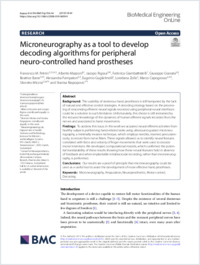Microneurography as a tool to develop decoding algorithms for peripheral neuro-controlled hand prostheses
- Petrini, Francesco M. Neuroengineering Lab, Department of Health Sciences and Technology, Institute for Robotics and Intelligent Systems, ETH Zürich, Switzerland. - Center for Neuroprosthetics, Ecole Polytechnique Federale de Lausanne, Campus Biotech, Geneva, Switzerland. - Bertarelli Foundation Chair in Translational NeuroEngineering, Institute of Bioengineering, School of Engineering, Ecole Polytechnique Federale de Lausanne, Campus Biotech, Geneva, Switzerland - Laboratory of Biomedical Robotics & Biomicrosystems, Università Campus Bio-Medico di Roma, Italy - IRCCS S.Raffale-Pisana,Rome, Italy
- Mazzoni, Alberto The BioRobotics Institute, Scuola Superiore Sant’Anna, Pontedera, Italy
- Rigosa, Jacopo Center for Neuroprosthetics, Ecole Polytechnique Federale de Lausanne, Campus Biotech, Geneva, Switzerland. - The BioRobotics Institute, Scuola Superiore Sant’Anna, Pontedera, Italy
- Giambattistelli, Federica Institute of Neurology, Università Campus Bio-Medico di Roma, Italy
- Granata, Giuseppe IRCCS S.Raffale-Pisana,Rome, Italy - Catholic University of the Sacred Heart, Rome, Italy.
- Barra, Beatrice Center for Neuroprosthetics, Ecole Polytechnique Federale de Lausanne, Campus Biotech, Geneva, Switzerland. - Bertarelli Foundation Chair in Translational NeuroEngineering, Institute of Bioengineering, School of Engineering, Ecole Polytechnique Federale de Lausanne, Campus Biotech, Geneva, Switzerland - Department of Medicine, Faculty of Sciences, University of Fribourg, Switzerland
- Pampaloni, Alessandra Center for Neuroprosthetics, Ecole Polytechnique Federale de Lausanne, Campus Biotech, Geneva, Switzerland. - Bertarelli Foundation Chair in Translational NeuroEngineering, Institute of Bioengineering, School of Engineering, Ecole Polytechnique Federale de Lausanne, Campus Biotech, Geneva, Switzerland
- Guglielmelli, Eugenio Laboratory of Biomedical Robotics & Biomicrosystems, Università Campus Bio-Medico di Roma, Italy
- Zollo, Loredana Laboratory of Biomedical Robotics & Biomicrosystems, Università Campus Bio-Medico di Roma, Italy
- Capogrosso, Marco Center for Neuroprosthetics, Ecole Polytechnique Federale de Lausanne, Campus Biotech, Geneva, Switzerland. - Bertarelli Foundation Chair in Translational NeuroEngineering, Institute of Bioengineering, School of Engineering, Ecole Polytechnique Federale de Lausanne, Campus Biotech, Geneva, Switzerland - Department of Medicine, Faculty of Sciences, University of Fribourg, Switzerland
- Micera, Silvestro Center for Neuroprosthetics, Ecole Polytechnique Federale de Lausanne, Campus Biotech, Geneva, Switzerland. - Bertarelli Foundation Chair in Translational NeuroEngineering, Institute of Bioengineering, School of Engineering, Ecole Polytechnique Federale de Lausanne, Campus Biotech, Geneva, Switzerland - The BioRobotics Institute, Scuola Superiore Sant’Anna, Pontedera, Italy
- Raspopovic, Stanisa Neuroengineering Lab, Department of Health Sciences and Technology, Institute for Robotics and Intelligent Systems, ETH Zürich, Switzerland.
-
08.04.2019
Published in:
- BioMedical Engineering OnLine. - 2019, vol. 18, no. 1, p. 44
English
The usability of dexterous hand prostheses is still hampered by the lack of natural and effective control strategies. A decoding strategy based on the processing of descending efferent neural signals recorded using peripheral neural interfaces could be a solution to such limitation. Unfortunately, this choice is still restrained by the reduced knowledge of the dynamics of human efferent signals recorded from the nerves and associated to hand movements.Findings: To address this issue, in this work we acquired neural efferent activities from healthy subjects performing hand- related tasks using ultrasound-guided microneurography, a minimally invasive technique, which employs needles, inserted percutaneously, to record from nerve fibers. These signals allowed us to identify neural features correlated with force and velocity of finger movements that were used to decode motor intentions. We developed computational models, which confirmed the potential translatability of these results showing how these neural features hold in absence of feedback and when implantable intrafascicular recording, rather than microneurography, is performed.Conclusions: Our results are a proof of principle that microneurography could be used as a useful tool to assist the development of more effective hand prostheses.
- Faculty
- Faculté des sciences et de médecine
- Department
- Département de Médecine
- Language
-
- English
- Classification
- Biological sciences
- License
-
License undefined
- Identifiers
-
- RERO DOC 324684
- DOI 10.1186/s12938-019-0659-9
- Persistent URL
- https://folia.unifr.ch/unifr/documents/307660
Statistics
Document views: 112
File downloads:
- pdf: 182
